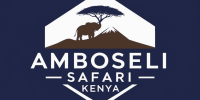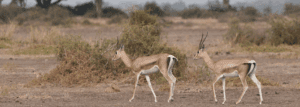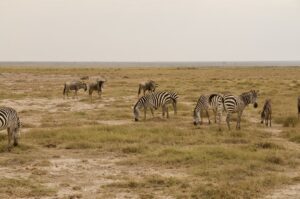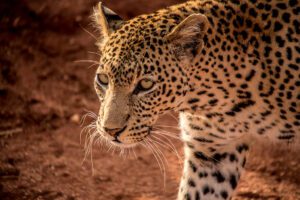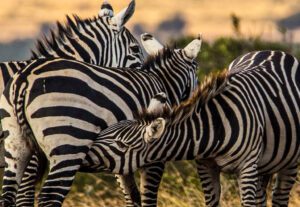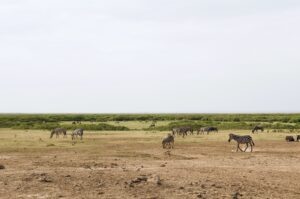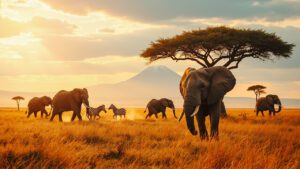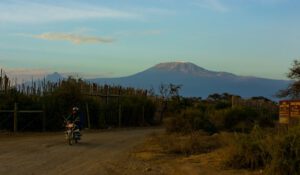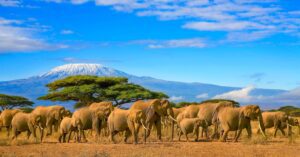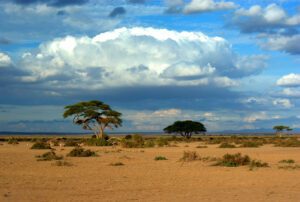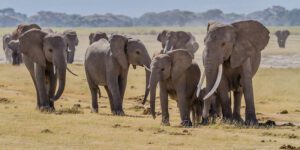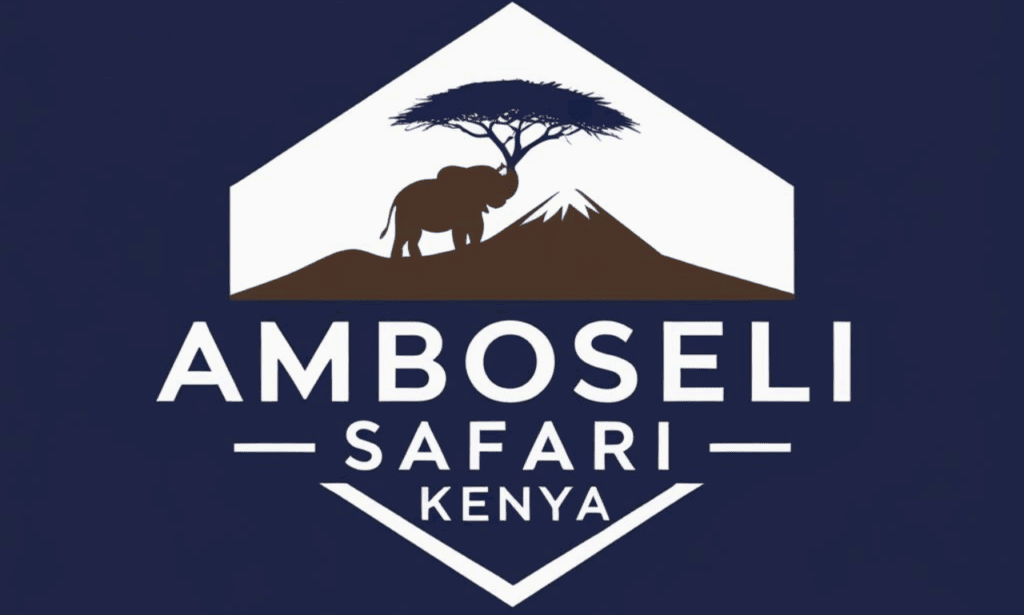What is Amboseli National Park, and where is it located?
Amboseli National Park is a renowned wildlife conservation area in Kenya, East Africa, celebrated for its abundant wildlife, particularly the iconic elephants. Covering about 392 square kilometers (151 square miles), the park is situated in southern Kenya, near the Tanzania border, making it one of the best places for a Kenya safari to witness animals in their natural habitat.
One of the striking features of Amboseli is its breathtaking views of Mount Kilimanjaro, the tallest mountain in Africa, located just across the border in Tanzania. This snow-capped peak creates a stunning backdrop, making Amboseli a favorite destination for photographers and filmmakers eager to capture the great wildlife and the beauty of the region.
The park is famous for its open savannah grasslands, where various animal species, including elephants, lions, and zebras, roam freely. While the land is generally flat and dusty during dry seasons, wetlands and marshes provide crucial water resources for the wildlife, attracting herds to drink and cool off.
Due to the easy visibility of wildlife in this terrain, Amboseli is particularly popular for tourists seeking a memorable safari experience. Whether you’re here to observe the large herd of elephants or immerse yourself in the African wilderness, Amboseli National Park is an incredible treasure in Kenya.
Why are the lions in Amboseli National Park significant or unique?
Lions in Amboseli National Park are significant because they play a crucial role in the ecosystem and have adapted to thrive in this renowned wildlife conservation area. As apex predators, they sit atop the food chain, hunting prey like zebras, wildebeests, and antelopes. This natural behavior helps maintain balance among various animal species, which is vital for the overall health of the ecosystem and supports the abundant wildlife found in the region.
What makes the lions in Amboseli unique is their habitat. Unlike lions found in areas with dense forests, the open savannah grasslands of Amboseli require these big cats to rely on stealth and teamwork to hunt effectively. This environment provides visitors with a distinct opportunity to observe lions and their behavior, as they are often more visible in this expansive landscape compared to those in heavily wooded areas. This visibility enhances the overall safari experience for wildlife enthusiasts.
Another unique aspect is their coexistence with the local Maasai people, who have a rich cultural history in this region. Traditionally, young Maasai warriors hunted lions as a rite of passage. However, in modern times, many Maasai are involved in wildlife conservation efforts, actively working to protect the lions while living alongside them, thus promoting harmony between the Maasai culture and wildlife.
Despite their ecological importance, lions in Amboseli face significant challenges, including habitat loss and human-wildlife conflict. Conservationists are dedicated to studying these lions to develop effective strategies for safeguarding their future in this vital part of the Kenyan wilderness, ensuring that both the iconic wildlife and the Maasai people can thrive together.
How many lions live in Amboseli National Park?
The estimated number of lions living in Amboseli National Park is relatively small, ranging from 50 to 100 lions. While this figure may appear low, it’s essential to consider that Amboseli is not as expansive as other renowned national parks like the Maasai Mara or Serengeti. Due to its smaller size, the park can only support a limited number of lions based on available resources, including prey animals and territory within this iconic wildlife habitat.
Since lions are territorial animals, the population is spread across different prides (or families). Each pride is made up of a group of related females and their cubs, along with one or a few dominant males who protect the pride and mate with the females. Young males eventually leave their birth pride to form their own groups or take over an existing pride.
Monitoring the lion population in Amboseli is crucial for effective wildlife conservation. Researchers track their numbers by observing prides and identifying individual lions through unique whisker patterns or scars, often utilizing technology like GPS collars. These methods are vital for determining whether the population is stable, growing, or declining in the context of the broader ecosystem.
Despite the relatively small number of lions, Amboseli remains a significant location for studying wildlife behavior. The coexistence of lions with abundant wildlife, including elephants and various animal species, makes it an essential area for understanding conservation efforts in this part of East Africa.
What is the habitat like for lions in Amboseli National Park?
The habitat for lions in Amboseli National Park is a mix of savannah grasslands, swamps, acacia woodlands, and dry, dusty plains, creating an environment that supports both predator and prey. Located in southern Kenya near the border of Tanzania, Amboseli is renowned for its open landscapes and dramatic views of Mount Kilimanjaro, the tallest mountain in Africa. This setting provides a unique backdrop for the lions that call it home, making it a prime destination for a Kenya safari experience.
The savannah grasslands are especially important for lions because they allow them to stalk and hunt their prey effectively. The golden grasses offer good camouflage, helping the lions blend in while hunting large herbivores like zebras and wildebeests. Meanwhile, the swampy areas, formed by underground water streams fed by Mount Kilimanjaro’s melting ice, provide crucial water sources for the entire ecosystem, attracting abundant wildlife. Lions often wait near these water sources since thirsty herbivores, like antelopes and buffalo, are more likely to gather there.
In addition, the acacia woodlands provide some shade and cover for both lions and their prey. These areas become particularly valuable during the hottest parts of the day, as they give the lions a place to rest and stay cool. However, since lions primarily hunt in the cooler hours, early morning, evening, or at night, the balance between open hunting grounds and shaded resting areas is crucial for their survival in this wildlife conservation area.
Examples of habitats within the park include the Enkongo Narok Swamp and the open Amboseli plains, which highlight this mix of terrain. This diverse environment not only supports lions but also a wide variety of other animal species, making Amboseli a critical area for conservation and a hub for great wildlife adventures.
What are the main prey species for lions in Amboseli National Park?
The main prey species for lions in Amboseli National Park include zebras, wildebeests, antelopes, and buffalo, all of which are herbivores that contribute to the park’s abundant wildlife. These animals form the foundation of the lions’ diet because they are large enough to provide a lot of food for the lion pride and their cubs. In the context of a Kenya safari, witnessing these interactions in the wild is a remarkable experience.
Wildebeests, for example, are one of the lions’ favorite targets as they often travel in large herds, making it easier for the lions to isolate weakened or younger members of the group. Zebras are also frequent targets because they often graze in open savannah grasslands, which gives lions the perfect opportunity to launch an ambush. However, zebras are very alert and can put up a strong defense using their powerful legs, so hunting them still requires teamwork.
Antelopes like the Thomson’s gazelle or Grant’s gazelle are smaller prey compared to wildebeests or zebras but are relatively fast and agile. These smaller species are sometimes targeted by younger or less experienced lions who are still learning how to hunt. Buffalos, on the other hand, are much larger and more dangerous to hunt. They are incredibly strong and often travel in protective herds, making them a challenge even for an experienced pride of lions. Still, lions will go after buffalo if they are desperate or if an opportunity presents itself, such as an injured or isolated individual.
Occasionally, lions may also hunt smaller animals like warthogs or hares, but these are not their primary food sources due to their size. The ecosystem’s diversity ensures lions have plenty of options, although competition with other predators, like hyenas, can limit their access to prey.
What are the biggest threats to the lion population in Amboseli National Park?
The lion population in Amboseli National Park faces several serious threats, including habitat loss, human-wildlife conflict, and competition with other predators. A significant aspect of this renowned wildlife conservation area is the need for effective strategies to protect these iconic wildlife. Additionally, factors such as climate change, poaching, and disease also put the lions at risk, making conservation efforts critically important.
One of the biggest threats is habitat loss, which occurs as humans expand settlements and agriculture into areas surrounding the park. As more land is converted for human use, lions’ territories shrink, forcing them to compete for limited resources. This can lead to a decrease in prey availability and increase the likelihood of lions wandering into human areas in search of food.
Human-wildlife conflict is another significant problem. Lions may kill livestock like cows and goats when their natural prey becomes scarce, and in retaliation, locals may poison or hunt the lions to protect their animals. This creates a cycle of hostility between humans and lions, further endangering the population.
Competition with other predators, like hyenas, also affects the lions by increasing the struggle for prey. Hyenas are skilled scavengers and often steal kills made by lions, which forces the lions to expend more energy hunting. This dynamic illustrates the challenges lions face in their quest for survival in the open savannah grasslands.
Climate change adds another layer of risk, as rising temperatures and unpredictable rainfall patterns can lead to droughts. These droughts may dry up water sources and reduce plant growth, leading to shortages of prey for lions. Other threats include disease outbreaks, which can spread quickly in a tightly-knit lion pride or from domestic animals nearby.
To address these dangers, it’s vital for organizations and local communities to work on conservation strategies, such as preserving lion habitats, promoting coexistence with humans, and creating programs that educate people about the importance of lions in the ecosystem. A united effort can help ensure that the Amboseli National Park remains a sanctuary for its diverse wildlife, including its famous elephant species and the majestic lions that roam its lands.
How does human-wildlife conflict affect the lions in Amboseli National Park?
Human-wildlife conflict is a serious problem for lions in Amboseli National Park, particularly when lions and people live in close proximity. Amboseli is unique not only for its abundant wildlife but also because it’s surrounded by local Maasai communities who depend on the land. Lions sometimes venture beyond the protected park boundaries, coming into contact with livestock such as cows, goats, and sheep. To the lions, these animals represent easy prey, especially when their natural prey, like zebras or gazelles, is harder to find in the open savannah grasslands.
Unfortunately, when lions attack livestock, it causes big problems for the local people, who depend on these animals for their livelihood. A single lion attack can mean a family loses valuable income or food. In retaliation, some communities may kill lions to protect their livestock and prevent further losses. This is especially true for the Maasai, who have a cultural tradition of protecting their livestock and sometimes hunting lions for status or revenge.
For instance, if a lion kills a cow at night, a herder might track the lion and spear it in the morning, both to safeguard the rest of their livestock and to send a warning to other lions. Over time, this pattern of conflict leads to fewer lions in the area, disrupting the natural balance and threatening their survival.
To make it worse, human expansion, like building new homes, farms, or roads, shrinks the lions’ space and creates even more opportunities for negative encounters. This conflict is a major threat to lion survival in Amboseli and across Africa.
Are there any conservation efforts in place to protect the lions in Amboseli?
Yes, many conservation efforts are being carried out to protect lions in Amboseli National Park! Most of these efforts focus on reducing human-wildlife conflict and helping both lions and local communities coexist peacefully. Here are some key examples:
One big solution is called predator compensation programs. These programs work by paying local communities when their livestock is killed by a lion or another predator. For instance, if a herder loses a cow to a lion, they are financially compensated. This reduces the need to retaliate by killing the lion, since they won’t suffer an economic loss. Conservation organizations often partner with the local government or donors to make this possible.
Another important conservation effort is working directly with the Maasai people. Programs like the Lion Guardians and Big Life Foundation hire local Maasai as wildlife monitors and educators. These Maasai help track lions, warn herders when lions are near their livestock, and teach others how to avoid conflict with wildlife. This way, the Maasai become active participants in protecting the lions, rather than seeing them as enemies.
Additionally, creating safe boundaries and protecting lion habitats is critical. Efforts to preserve migration corridors (areas that connect protected parks like Amboseli to other neighboring ecosystems) help lions and other wildlife move freely without running into human settlements.
Lastly, education and awareness campaigns are vital. Teaching people who live near Amboseli about the value of lions to the environment, like how lions keep prey populations healthy, can help foster appreciation for their presence. Conservation groups also work with rangers to enforce anti-poaching laws.
These combined efforts are making a difference, but more work is needed to ensure that lions in Amboseli thrive.
How do the lions in Amboseli coexist with other wildlife in the park?
Lions in Amboseli National Park coexist with other wildlife in a delicate balance that reflects the way ecosystems work. As apex predators, lions are at the very top of the food chain and mainly hunt herbivores like zebras, wildebeests, and antelopes living in Amboseli. By hunting these prey animals, lions help control their populations, ensuring the ecosystem remains stable. This balance is crucial for the great Kenya wildlife experience, where various animal species thrive.
For example, without lions preying on wildebeests, their numbers could grow excessively, leading to overgrazing of grasses. This overgrazing would negatively impact other animals like gazelles, which also depend on the same vegetation. Thus, lions play an indirect but vital role in maintaining the health of the ecosystem, contributing to the wildlife conservation efforts in the region.
Simultaneously, lions must share Amboseli National Park with other predators, such as hyenas, leopards, and cheetahs. These predators often compete for food. For instance, if a lion kills a zebra and leaves it unguarded, smaller predators like hyenas might attempt to steal it. This competition creates tension among predator species but is a natural part of the ecosystem. Lions often hunt in groups (called prides), giving them an advantage over solitary hunters like leopards.
Interestingly, lions also coexist with scavengers like vultures and jackals. After lions finish eating their prey, scavengers clean up the remains, leaving almost no waste behind. This role-sharing benefits the entire ecosystem.
Finally, lions typically avoid herbivores that are not prey, such as elephants and rhinos. Elephants, particularly, can be aggressive and will chase off lions if they feel threatened. In this way, even the largest herbivores contribute to maintaining ecological balance, creating a fascinating web of interactions in Amboseli National Park, a renowned wildlife conservation area.
What role do the Maasai people play in lion conservation around Amboseli?
The Maasai people play an incredibly important role in lion conservation around Amboseli National Park. The Maasai are an Indigenous community who have lived in the areas surrounding Amboseli for generations and have a strong cultural connection to the land and wildlife. Traditionally, lions and the Maasai have a complicated history. In the past, it was a rite of passage for young Maasai warriors (known as “morans”) to hunt and kill lions as a display of bravery and strength. However, with the declining lion population and changes in conservation awareness, this practice has largely been replaced with less harmful ways of earning respect, such as participating in conservation efforts.
Today, the Maasai play a key role in protecting lions. Many Maasai communities engage in programs that focus on promoting coexistence between people and wildlife. For example, the Maasai are involved in initiatives like the “Lion Guardians” program. In this program, community members are trained to track lion movements, help prevent conflict between lions and livestock, and educate others about the importance of conserving lions. Instead of hunting lions, these trained Maasai individuals now work as protectors of lions, spreading awareness about their ecological importance.
The Maasai also contribute by managing human-wildlife conflicts. Since many of them rely on livestock as a source of livelihood, they often experience issues when lions prey on their animals. However, conservation organizations in partnership with the Maasai have created compensation programs that reimburse families for livestock lost to predators. This reduces the incentive to retaliate by killing lions.
Through their deep understanding of the land and wildlife, their cultural adaptability, and participation in conservation programs, the Maasai have shifted from being seen as lion hunters to some of the lions’ most important allies. Their involvement is critical to ensuring the survival of lions in the Amboseli ecosystem.
Are there any research programs or studies focused on the lions of Amboseli?
Yes, there are several research programs and studies focused on the lions of Amboseli National Park, a renowned wildlife conservation area. These studies help scientists and conservationists better understand lion behavior, population dynamics, and the challenges they face, which ultimately aids in their conservation. One notable program is the “Lion Conservation Project,” which monitors the lion population in Amboseli and surrounding areas. The researchers track lions using GPS collars, allowing them to follow their movements and assess how they use the habitat. By doing this, scientists gain insights into lion territories, hunting habits, and their interactions with various animal species, including the large carnivores that roam the savanna.
A key focus of this research is studying how lions live in a semi-arid, human-dominated landscape. Unlike lions in other regions, the lions in Amboseli must coexist with high human activity, especially Maasai pastoralists who graze livestock nearby. Researchers collect data on how lions adapt to this environment, including their nocturnal behavior. For instance, lions in Amboseli tend to avoid humans during the day and hunt more actively at night, showcasing their adaptability in this challenging environment.
Another element of lion research in Amboseli involves genetic studies. By collecting DNA samples from lion scat or fur, scientists can determine how connected the lion population in Amboseli is to other lion populations in Kenya and beyond. This research is essential for maintaining genetic diversity, which is key to the long-term survival of the species and the overall health of wildlife resources in the area.
Finally, many studies focus on human-wildlife conflict. Researchers examine the causes of conflict, such as livestock depredation, and work with communities to develop solutions. Conservation organizations and donors often fund these studies, and local Maasai people sometimes assist as trackers or field assistants, fostering a collaborative approach to wildlife conservation.
These research programs have significantly improved our understanding of Amboseli’s lions and have contributed to the development of effective conservation strategies. Without this research, it would be much harder to ensure these iconic animals continue to thrive in the wild, particularly in an area known for its abundant wildlife and rich Maasai culture.
How can tourists and visitors observe lions responsibly in Amboseli National Park?
Tourists can play a big role in wildlife conservation by observing lions responsibly and minimizing their impact on the environment. Watching lions in their natural habitat can be an unforgettable experience, especially during a Kenya safari, but it’s important to do so in ways that respect the animals and their surroundings. Responsible tourism not only protects lions but also ensures that the experience is safe and enjoyable for everyone, both humans and wildlife.
First, tourists should always stick to the park’s designated paths and roads when on safari. Driving off-road can disturb lion habitats and damage the fragile environment of Amboseli National Park, which is known for its iconic wildlife. Guides and drivers are trained to follow these rules, so it’s important to listen to them and not pressure them into breaking the rules to get closer to lions.
Second, it’s crucial to keep a respectful distance from lions. Lions might seem relaxed when lying in the grass or walking near roads, but they are wild predators and can react unpredictably if they feel threatened. Approaching too closely can stress them out and disrupt their natural behavior. Tourists should stay quiet, avoid sudden movements, and never feed or interact with the lions.
Another important point is to support eco-friendly tour companies and lodges that prioritize conservation and sustainable practices. Many of these companies ensure that a portion of the profits goes back to lion conservation efforts and local community development. Some lodges even employ local Maasai as guides, providing guests with culturally rich experiences while creating jobs for the community.
Lastly, tourists can take the time to educate themselves about Amboseli’s lion conservation challenges before their visit. Guides often share fascinating details, but understanding issues like habitat loss and human-wildlife conflict ahead of time can help visitors appreciate the importance of observing responsibly. By being mindful and respectful, tourists can create memories of a lifetime while contributing to the long-term survival of these magnificent animals.
